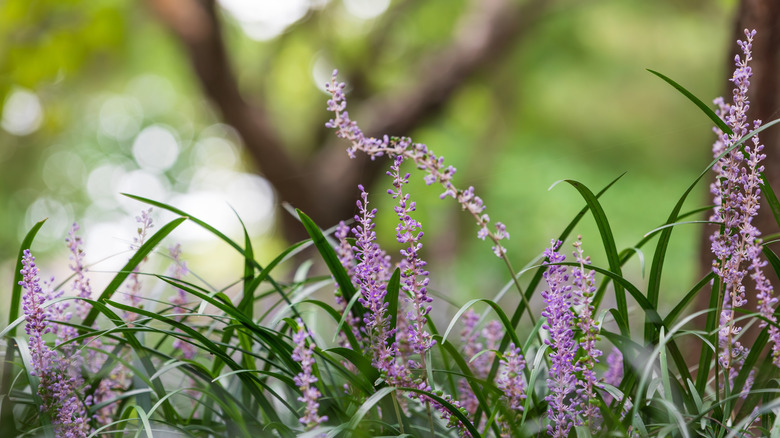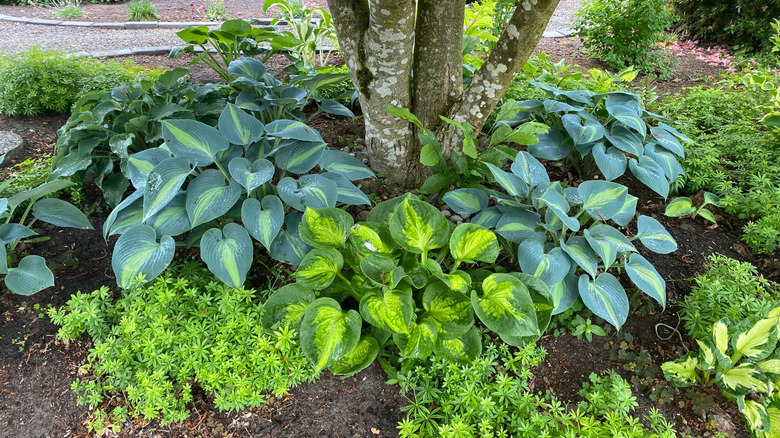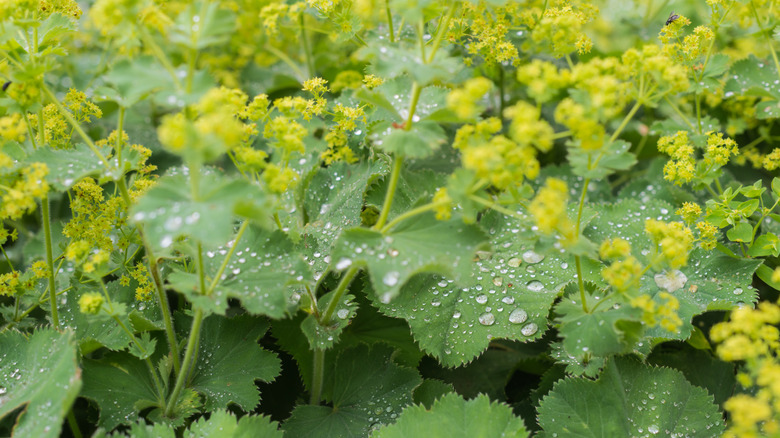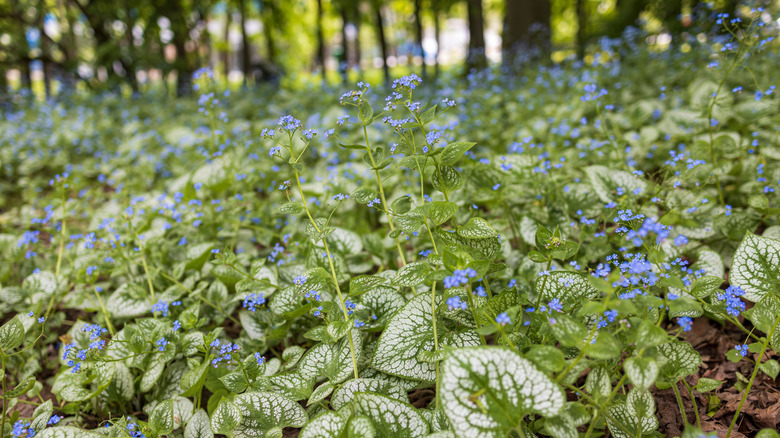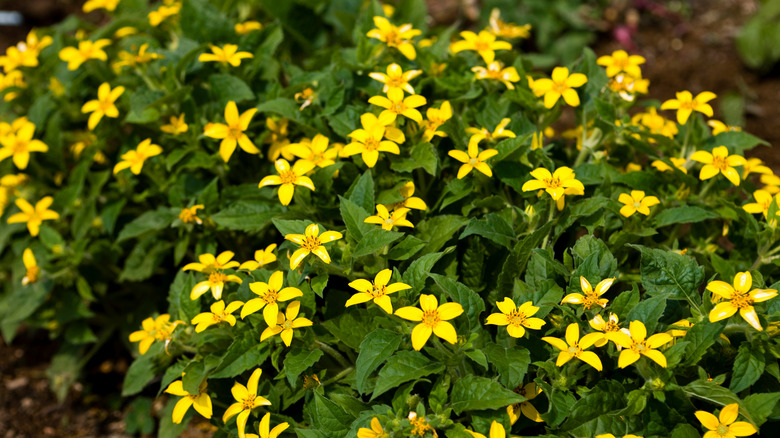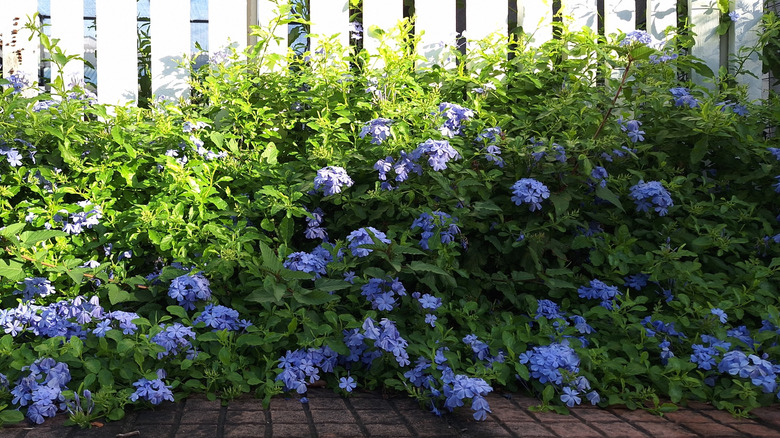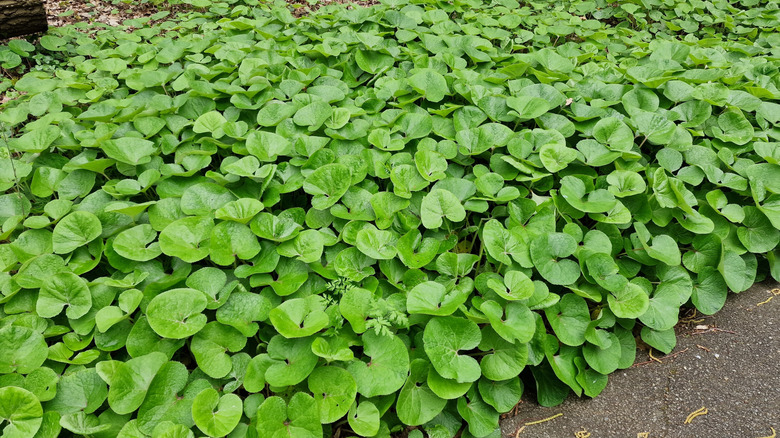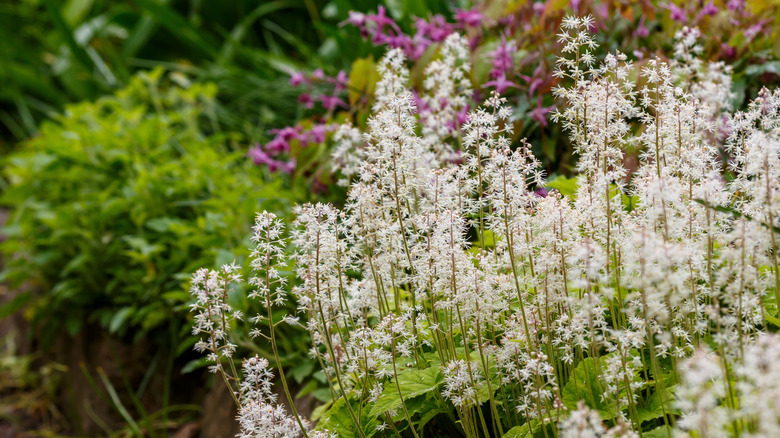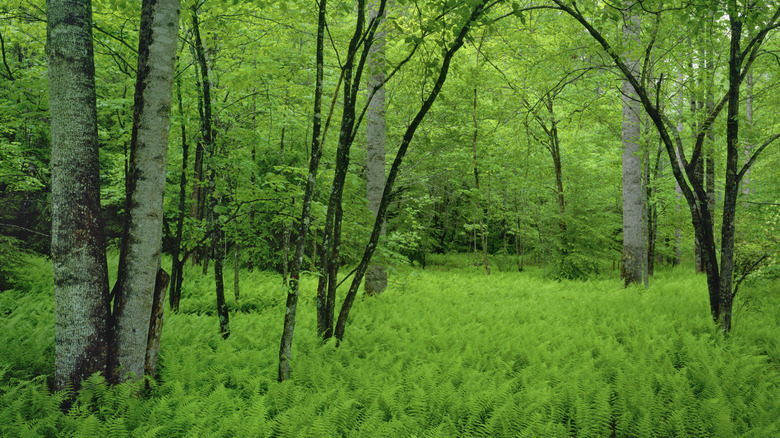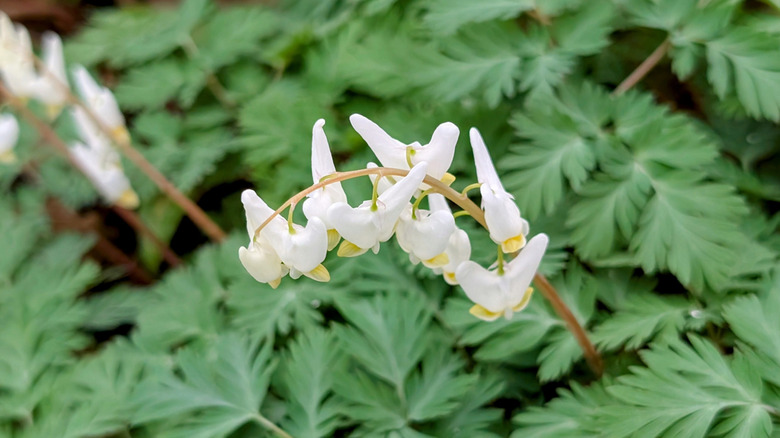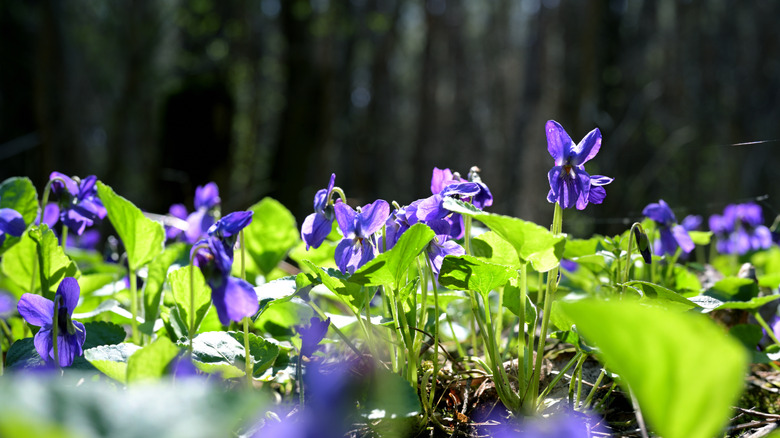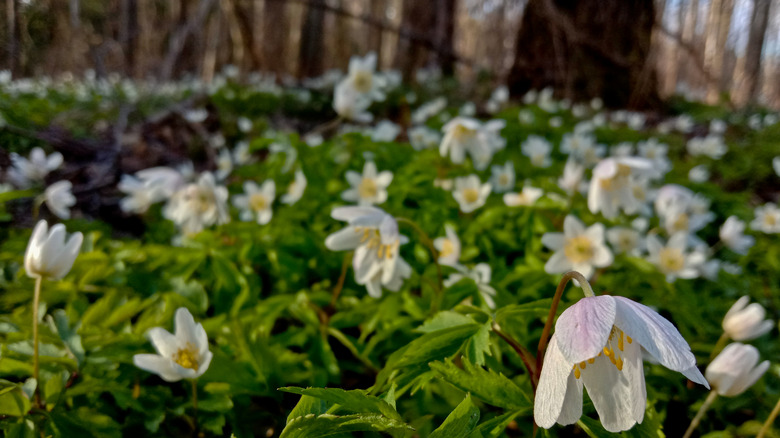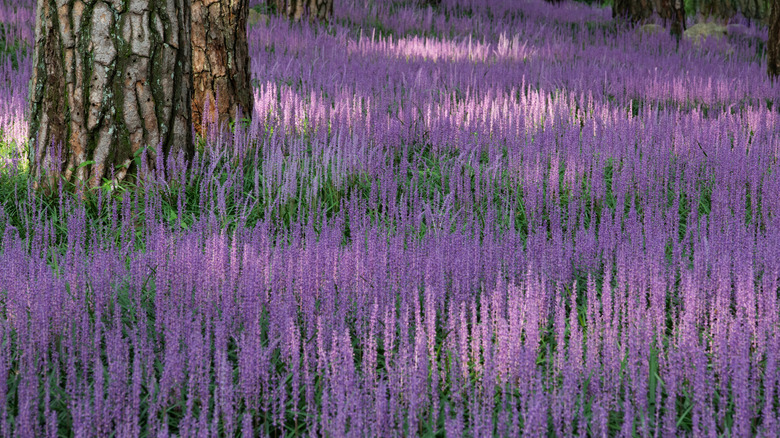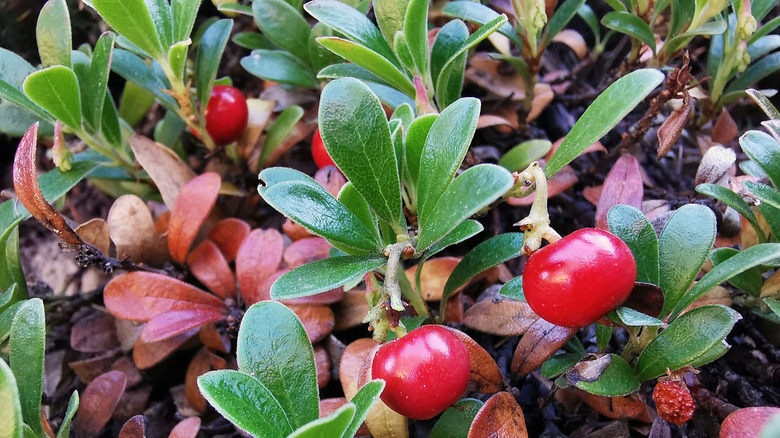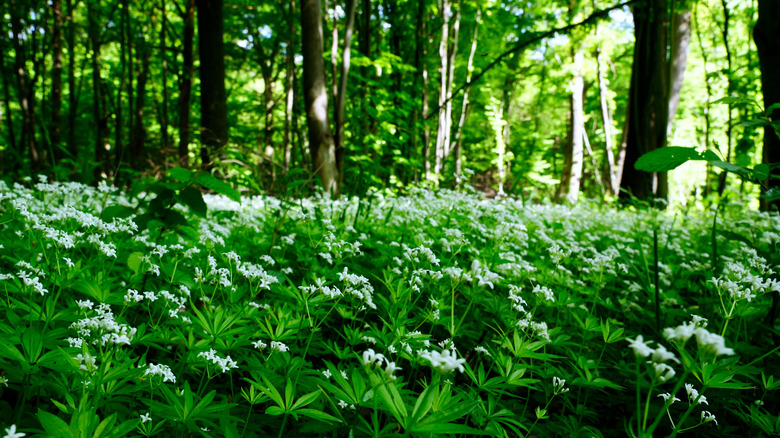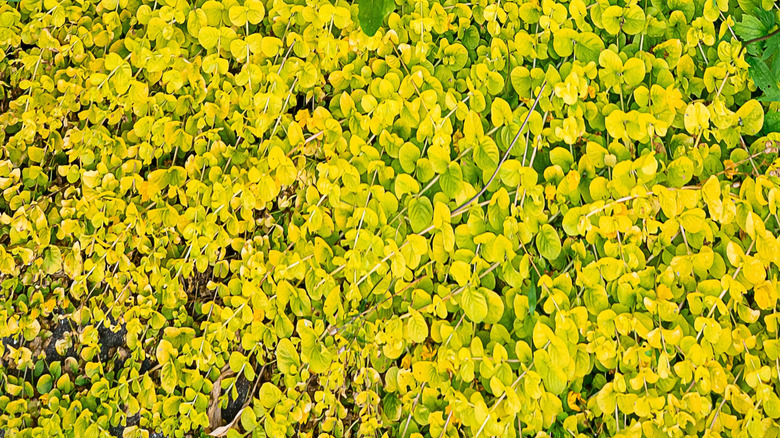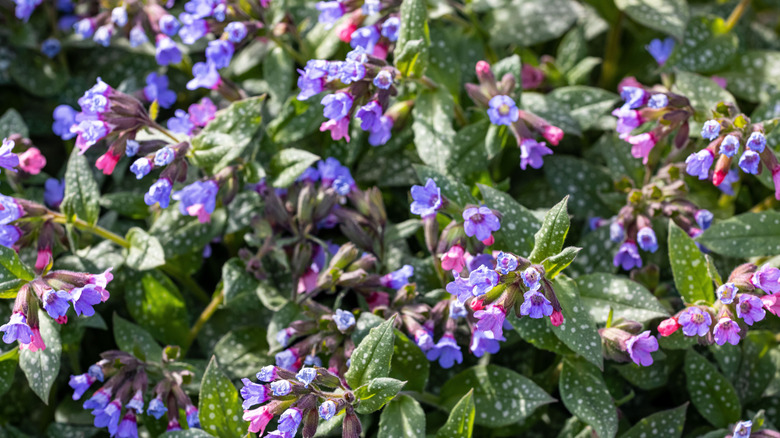16 Of The Best Ground Covers To Plant Under Shade Trees In Your Garden Or Yard
Magnificent, spreading shade trees do more than simply add drama to your landscape. They also provide respite from the heat, control erosion, and increase property values. Yet with all of those advantages, trees can be a challenge to underplant. Even the lushest lawns are no match for the lack of sunlight at the trees' base.
Ground cover offers an ideal solution for underplanting shade trees in your garden or yard. These popular plants can cover bare tree roots while also suppressing weeds. Best of all, you can introduce a wide range of colors and textures with different ground covers.
However, it's important to select shade-loving perennials that also match the climate and soil conditions of the area around the tree's root system. So, keep issues such as the pH levels in mind. For example, many evergreen trees tend to thrive in acid soil, so you'll want a ground cover that can handle lower pH levels. Also consider that some shade trees, such as oak, pine, and hemlock, don't like to be disturbed by other deep-rooted plants. With all of that in mind, here's how to select ground cover for below your trees.
Hostas create showy but fuss-free drama
Hostas (Hosta spp.) are a great ground cover option under shade trees, and they spread via clumping rhizomes rather than invasive roots. Hostas provide tons of big, glossy foliage from spring to fall, as well as spikes of delicately-hued flowers partway through their growing season. While the classic hostas are large-leaved and deep green, there are hosta varieties with leaves and flowers in other shades, too. Varieties that feature chartreuse leaves or variegated foliage really brighten the area under trees. Depending on the variety, you can expect hostas to grow to between 12 and 30 inches tall.
Hostas grow best in zones 3 to 8, and like a medium amount of water. Most types grow best under trees that provide full or partial shade. They can even tolerate trees like the notoriously tricky black walnut, which secretes natural toxins that kill many other plants.
Lady's mantle glows under dappled shade trees
Both a traditional medicinal herb and a beautiful ground cover plant, lady's mantle (Alchemilla mollis) is famous for the perfectly round dewdrops that form on its fuzzy, pale leaves each morning. The plants also contribute froths of yellow-green flowers that add a bit of color and interest under a shade tree. Lady's mantle ground covers do best in partial shade, and their height and spread are similar to hostas, making them best suited in single-specimen groupings, rather than trying to pair them with other ground covers.
Give your lady's mantle plants a medium amount of water, and keep an eye on rainfall totals because they don't do well if their soil dries out. Depending on the cultivar, most lady's mantle ground covers grow best in zones 3 to 8. They're also considered somewhat resistant to deer and rabbits, as well as to most insect infestations and serious plant diseases.
Siberian bugloss flowers provide masses of color
Also known as false forget-me-not, Siberian bugloss (Brunnera macrophylla) throws up clouds of tiny blue-petaled flowers with striking white or yellow centers. The heart-shaped leaves are equally pretty. For growing under trees, consider Siberian bugloss 'Jack Frost,' with its silvery-white foliage to truly brighten the area. In fact, this cultivar was named the Perennial Plant of 2012. The stunning silver foliage, set off by green veining, is tailor-made to lighten up a dark understory. Because the spreading plant seldom grows taller than 18 inches, it can be interplanted with spring bulbs or taller plants, such as ferns.
Plant Siberian bugloss under trees that provide a touch of sun in the morning, then afternoon shade. This ground cover tolerates both neutral and clay soils, but prefers a rich bed with medium watering, and does best in zones 3 to 8. Wait until spring to remove the previous year's foliage, as those older leaves protect the plants during winter.
Goldenstar lights up evergreen trees
Whether you know it as "goldenstar," "golden knee," or "green and gold," this low-grower (Chrysogonum virginianum) brightens up the area around shade trees with its daisy-like flowers and small oval leaves. Goldenstar is a native ground cover that originated in the southeastern U.S., but can be grown throughout zones 5 to 9. It will bloom more dependably throughout the season in areas on the cooler end of that spectrum. But even in warmer zones, the cheerful yellow flowers tend to die back in summer, sometimes reappearing in fall. It is one of the shorter of the ground covers, creating a striking mat that reaches up to about 12 inches.
Goldenstar is spread by rhizomes and is resistant to pests and diseases. Because it likes acid soil, the ground cover works especially well under evergreen shade trees. But even if they're under deciduous trees, you can work in amendments like peat moss or sphagnum peat moss to further lower the pH level of the soil.
Woodland phlox thrives under a variety of trees
Woodland phlox (Phlox divaricata), also called wild sweet William, is known for its vigorous profusion of fragrant blue flowers and plentiful foliage. These native North American flowers can handle either deep or partial shade, making them versatile ground cover under a variety of shade trees. Woodland phlox plants are a bit taller than the sun-loving creeping phlox varieties with which you might be more familiar. It's also shallow-rooted, ideal for even touchy trees that hate root disturbance. Depending on the cultivar you choose, their flowers range from pale blue ('May Breeze') to a more intense blue-violet ('Blue Moon'). For extra fragrance, choose a cultivar such as 'Clouds of Perfume.'
Establish woodland phlox into a bed that's been enriched with compost and topped with a light mulch. Mulch is especially important for keeping this ground cover's roots protected from the heat. The plants prefer medium water and can tolerate a bit of drought.
Wild ginger spreads quickly in moist conditions
When you want a truly low-growing ground cover that can handle even damp growing conditions, wild ginger is your best bet. The American native wild ginger, Asarum canadense, or its European cousin, A. europaeum, are fairly interchangeable as ground covers under trees. The intriguing, burgundy-hued flowers tend to hide among the cup-shaped leaves, but are worth the close perusal to see the unusual blooms, which resemble a tricorne hat. It's the glossy foliage, however, that really steals the show with this classic ground cover.
Wild ginger does well in moist to wet soils and full shade. Because it likes wet conditions, the ground cover is an especially helpful companion for trees that thrive in damp soil, such as pin oak, American sycamore, or river birch. When possible, group it in larger clumps under trees.
Foam flowers add a fairytale touch
If you like the striking foliage of coral bells but need something that can take more shade (and contribute springtime blooms to boot), foam flowers (Tiarella cordifolia) may be the answer to your prayers! As their name suggests, foam flowers produce frothy white or pink blooms. The foliage on foam flowers resembles maple or oak leaves, making them a playful choice to establish under either of those shade trees. The leaves turn a handsome bronze in autumn in cooler climates, and stay green in more temperate zones. These low-growers can co-exist with a variety of other ground covers or stand on their own.
Foam flowers do best with watering about once a week during the growing season. Give the plants slightly enriched soils. They're not troubled much by pests or disease, and will do better if you remove spent flowers after their blooming season. They grow best in zones 4 to 9.
Ferns bring woodland charm to every backyard
There's nothing like a group of waving ferns to really bring the magic of the forest into your own backyard. And there are so many ferns that work well as ground covers for shady areas with a wide variety of growing conditions. In general, the impressive height and spread of these majestic plants are perfect for softening unsightly root systems and scraggly tree trunks.
One of the tallest ferns around, the ostrich fern (Matteuccia struthiopteris), reaches heights of up to 6 feet, although around 3 feet is more common. The lady fern (Athyrium filix-femina) is another tall type, at about 3 feet tall. Lady fern also provides a lacy look under trees than sturdy ostrich ferns. If you'd like a shorter option, the marginal wood fern (Dryopteris marginalis) has a height and spread of about 18 to 24 inches. If you'd rather have something a little brighter to light up deep shade, opt for Japanese painted fern (Athyrium niponicum). It has a similar height and spread as the marginal wood fern, but has silvery fronds with streaks of deep red.
In general, ferns prefer medium or wet soil and part shade or full shade. But if your shade tree's requirements differ, don't despair! There's apt to be a fern that meets your needs as a ground cover. Lady fern, for example, can handle drier soil than most other ferns.
Dutchman's breeches add whimsy under shade trees
What if you love the look of woodland ferns, yet yearn for a flowering ground cover? Dutchman's breeches (Dicentra cucullaria) offer the ideal compromise. The ground cover's foliage is indeed reminiscent of ferns, while its striking white flowers will remind you either of butterflies or upside-down pants! The early-spring blooms of Dutchman's breeches are winged and white, and strung out almost laterally on their slender stems. The plant is low-growing, tending to reach about 5 to 10 inches in height.
Dutchmen's breeches can take either full or part shade and like moist growing conditions. One thing to be aware of, however, is that this ground cover may be best paired with other flowering plants, as the entire plant tends to go dormant in the height of summer. So, you might like to follow the first wave of Dutchmen's breeches with one or more of the summer-blooming flowers that grow well in shade.
Violets bring old-fashioned charm and heart-shaped leaves
For lovers of classic wildflowers and native plants, nothing beats the violet (Viola spp.). Even after its famous purple blooms have gone by, this ground cover's heart-shaped leaves continue to lend a touch of poetry to the ground beneath shade trees. Depending on your climate, there's a violet species or cultivar to meet your needs.
The common blue violet (V. sororia) thrives throughout zones 3 to 7. Sweet white violet (V. blanda) grows as far north as zone 2, while horned violet (V. cornuta), a tricolor type, can handle the heat of zone 11. Violets tend to grow no taller than 5 to 7 inches. Spreading both by runners and by self-seeding, they can become aggressive if they stray too close to lawns and garden beds. As an understory plant, violets are best paired with trees that offer dappled shade and prefer moist soils. If the area isn't naturally moist, water the plants frequently.
Wood anemone glows whitely under moisture-loving trees
From this ground cover's name alone, it's obvious that wood anemone and shade trees are natural companions. The ground cover is prized for its multi-petaled flowers that look like white buttercups. Both the North American native wood anemone, Anemonoides quinquefolia, and its European cousin, Anemone nemorosa, prefer moist soil and shade, although the American type can also handle deep shade. With a height and spread of about 6 to 18 inches, both the American and European wood anemones have dark green leaves in groups of three with white petal-like sepals that sometimes take on pink streaks. They also have a center circle made up of wavering yellow stamens.
Establish your wood anemone plants under trees that love damp but not boggy soil. Wood anemones look especially stunning in large drifts that link a small grove of trees together. American wood anemone grows in zones 3 to 8, and the European type is slightly less cold-hardy, growing best in zones 5 to 8.
Lilyturf works with a variety of shade trees
For spiky drama and fanciful purple hues, nothing beats lilyturf (Liriope muscari or L. spicata). This ground cover's leaves resemble tall grass that produces slender violet flowers. Lilyturf can handle versatile growing conditions, making it a charming way to grow "grass" under trees whose shade kills actual lawns.
Depending on the lilyturf species and cultivar you choose, your options include the more common lavender-hued lilyturf, along with those featuring purple, white, or yellow flowers. The L. spicata species, sometimes called creeping lilyturf, is the shorter of the two, with grass-like leaves and flowers that seldom top 18 inches. L. muscari, or "big lilyturf," has larger leaves and stands about 24 inches tall, and has more cultivars from which to choose.
Choose your species and/or cultivar based on the climate and shade conditions of the area under your tree. For example, cultivars with variegated leaves do best in deep shade. In general, lilyturf is deer resistant and everything from air pollution and salty breezes to drought.
Bearberry thrives in dry shade and cool climates
Perfect under dry-shade trees and for drought-tolerant landscaping, bearberry (Arctostaphylos uva-ursi) is a low-growing ground cover that provides year-round drama. Its branches bristle with waxy green leaves in the summer, turning a handsome auburn in winter. Bearberry also produces springtime flowers, followed by bright red berries in the fall. It's also unusually cold-hardy.
The evergreen low shrub grows up to 6 feet across, although it does take some time to achieve that full spread. True to the plant's name, bears do indeed like the berries, as do other kinds of wildlife. Bearberry prefers dry, sandy, or even rocky soils. It does not, however, appreciate total darkness. So, use bearberry under trees whose leaves tend to cast dappled shade. If your shade tree is on a sloping part of your yard, the evergreen shrub is ideal for erosion control. Bearberry does best in zones 2 to 6.
Sweet woodruff adds fragrant beauty to damp shade areas
Trees that cast deep shade and thrive in moisture are among the most challenging to underplant. Yet that's exactly where sweet woodruff (Galium odorata) happens to shine. This ground cover, also known as sweet-scented bedstraw, emits a hay-like fragrance and happily exists in dark, damp areas. Sweet woodruff, a classic potpourri herb, is also the basis for the traditional May wine. But even if you don't wish to harvest the plant for its fragrance or winemaking, you're bound to be enchanted by the delicate whorls of leaves and fragrant white flowers. The plants grow to about 6 to 12 inches tall.
Sweet woodruff naturalizes quickly, with the possibility of becoming too vigorous in its preferred shady, moist conditions. Check to make sure your state doesn't consider them invasive. Otherwise, the plants are easily mowed if the grouping needs some cutting back. They thrive in zones 4 to 9.
Creeping Jenny shines like gold coins in dappled shade
Also known as moneywort, creeping Jenny (Lysimachia nummularia) is one of the lowest-growing ornamental perennials around. It's also ideal for moist soil conditions and partial shade. Choose a cultivar such as creeping Jenny 'Aurea' to really light up shady areas under trees. Both the leaves and the flowers of the ground cover shine in varying shades of yellows and greens. In summer, the rambling stems produce masses of cup-like, bright yellow flowers.
Creeping Jenny has a fairly broad growing range, thriving in zones 3 to 9, and it appreciates enriched, moist soil. It tends to be more invasive in the Northeastern U.S. Place creeping Jenny under a tree that produces dappled shade, or use it to edge other ground covers that can take the deeper shade surrounding the trunk. Creeping Jenny's golden color makes an especially nice contrast with the reddish or bronze varieties of coral bells.
Lungwort lights up deep shade
Although lungwort (Pulmonaria officinalis) is best known for its silver- or white-splotched leaves that vividly brighten shady areas, this ground cover also produces flowers that bloom pink, then turn violet as the season progresses. It does well under the shadiest trees, but can also take a bit of dappled light. The strikingly speckled ground cover lungwort gets its unexpected name as a former medicinal herb once used to treat bronchial issues. The ground cover grows about 9 to 18 inches tall and produces flowers in the spring. Because the blooms change color over time, it's not uncommon to see differently-colored blooms on the same plant.
Depending on the cultivar, lungwort does best in zones 3 to 8. The ground cover prefers medium-moist soil, struggling with both damp soil and drought. In temperate areas, lungwort's leaves will retain some greenness even in the winter months.
